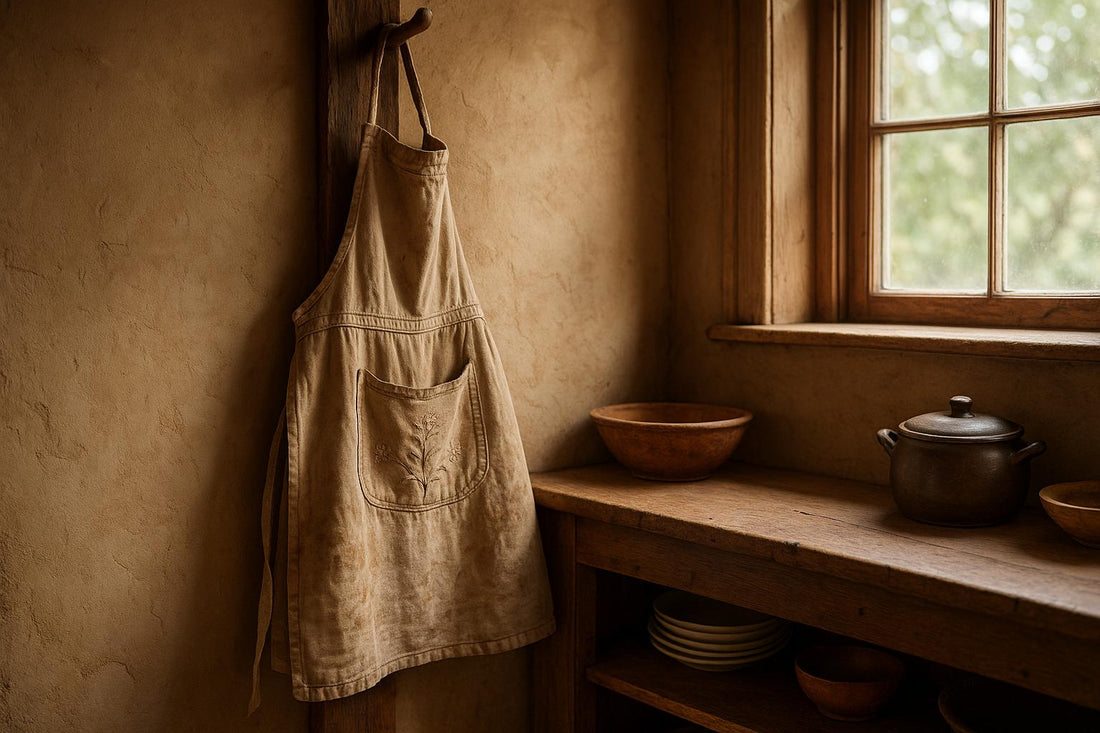
History of Aprons in North America
Share
Aprons in North America have evolved from simple protective garments to symbols of social roles, creativity, and practicality. Native Americans used aprons in daily life and ceremonies, while European settlers brought functional designs that later reflected social status. By the 20th century, aprons became icons of domestic life, especially in the 1950s, but their role shifted with changing gender norms. Today, aprons focus on functionality with features like adjustable straps and durable materials, catering to modern needs while connecting to their rich history.
Key Points:
- Native American Origins: Aprons held spiritual and practical significance, often crafted with intricate designs.
- Colonial Influence: Early settlers used aprons for utility, evolving into markers of status and roles.
- 19th-20th Century: Industrialization introduced new materials and styles, while economic hardships sparked resourceful designs like flour sack aprons.
- 1950s Domestic Symbol: Became a hallmark of homemaking, heavily promoted in media.
- Modern Aprons: Focus on durability, comfort, and eco-friendly materials, catering to diverse users like chefs, crafters, and hobbyists.
Aprons remain relevant, blending functionality with a connection to past traditions, making them timeless tools for work and creativity.
Lunch and Learn: The Amazing History of Aprons
Early Apron Use by Native Americans and Colonists
Aprons in North America trace their origins to two distinct traditions: Native American craftsmanship and the customs brought by European colonists. These two approaches eventually blended, creating a uniquely North American apron heritage. By exploring these early practices, we can better understand how economic and social changes shaped apron styles over time.
Native American Apron Practices
For Native American communities, aprons were more than just functional garments - they carried cultural and spiritual significance. Made from materials like buckskin, valued for its strength and flexibility, aprons were used in both daily life and ceremonial events. Among Woodlands tribes, ceremonial aprons crafted from black velvet featured intricate designs inspired by nature, brought to life with appliqué, embroidery, and beadwork. These aprons often took center stage during pow-wows and other important gatherings.
Different regions showcased unique styles and techniques. For example, the Kwakiutl people of the Northwest Coast became known for their ceremonial button blankets adorned with clan crests and symbols, which played a key role during potlatches. In Florida, the Seminole and Miccosukee tribes elevated ribbonwork into an art form, using colorful ribbons to create complex patterns that would later influence broader textile traditions in the United States.
Beyond their practical use, these garments often carried deep spiritual meaning. In the Creek Ribbon Dance, women wore headdresses adorned with cascading, rainbow-colored ribbons, celebrating their roles within the community during annual ceremonies. Over time, European contact introduced new materials like glass beads and silk ribbons into Native American designs, leading to a fusion of traditional and imported elements. These hybrid styles preserved cultural identity while expanding the creative possibilities of apron-making.
Colonial Aprons: Practical Design Meets European Style
European settlers brought their own apron traditions to North America. Initially, aprons served a purely practical purpose, with early settlers favoring plain white aprons for protection. However, as colonial settlements grew and prospered, aprons began to reflect social status. In New England, wealthier women embraced more decorative options, such as embroidered or dipped aprons, to complement their gowns.
By the 18th century, apron styles had become a marker of social roles. Servants typically wore simple white aprons that were expected to be "clean, neat and appropriate", emphasizing the structured nature of domestic service. In contrast, affluent housewives showcased their status with aprons made from luxurious materials like black lace, satin with chenille borders, or shot silk. Even the time of day influenced apron choices; maids might wear printed dresses with daytime aprons but switch to black dresses paired with formal aprons for evening duties.
Cultural exchanges between Native Americans and Europeans also shaped apron traditions, though these interactions often occurred under unequal power dynamics. Some Europeans, like colonial Francis Higginson, expressed discomfort with Native American clothing practices, describing them as wearing "something before their Privities" while otherwise unclothed. Despite such judgments, influences flowed in both directions. Europeans adopted Native American elements like furs and feathers, while Native Americans incorporated European fabrics into their designs.
"The natives were gentle and amiable, graceful in figure, agile in movement, and exhibited unusual taste, dressing their hair in a variety of twists and braids, intertwined with ornamental feathers….They also dye their hair, which some wear long, others short, others on one side only." - Samuel de Champlain
These early interactions laid the groundwork for apron styles that would evolve over centuries. The blending of practical needs, social customs, and cultural influences created the foundation for the distinctly American apron designs that continue to develop today.
Aprons in the 1800s and Early 1900s
During the 19th and early 20th centuries, aprons in North America underwent a significant transformation. The Industrial Revolution not only changed how goods were made but also influenced how aprons were perceived and used. Once simple garments meant to protect clothing, aprons became symbols of social class, economic conditions, and evolving gender roles. This period saw the shift from handmade to factory-produced items, with economic challenges sparking creative solutions and new styles that reflected the resilience and ingenuity of the time.
New Materials and Economic Shifts
In their earliest form, aprons were straightforward pieces of fabric designed to shield clothing from dirt and wear. But by the 1800s, advances in manufacturing and the availability of new materials transformed them into more elaborate garments. Luxurious fabrics like satin and shot silk became popular for morning and afternoon aprons, especially among the growing middle and upper classes, reflecting their rising affluence. Materials such as muslin, silk, and serge were commonly used, offering both durability and a way to display social standing.
However, these finely crafted aprons came with a higher price tag, making them less accessible to working-class families. Economic challenges, particularly during the Great Depression, led to resourceful adaptations. Women found ways to make aprons from flour sacks and leftover fabric scraps, turning necessity into creativity.
Apron Styles Across Social Groups
The changes in materials and manufacturing also influenced apron styles, which became markers of social class and occupation. While handcrafted traditions persisted, industrial advances introduced new designs that combined practicality with symbolism. Throughout the 1800s, aprons served as visual indicators of hierarchy and professional identity. For example, maids typically wore plain white cotton aprons for their utility, but in wealthier households, staff uniforms were strictly regulated. A housemaid might wear a printed dress during the day but switch to a black dress paired with a matching apron for evening duties.
In contrast, affluent housewives used aprons to showcase their family’s wealth. These aprons often featured opulent materials like black lace, satin trimmed with chenille, or shot silk, standing in sharp contrast to the simpler cotton aprons worn by servants. A specific style, known as "pinners", became associated with parlor maids in the 1800s, blending practicality with a clear display of social status.
Art from the era also captured these distinctions. For instance, Mary Ellen Best’s painting "Scene in Frankfurt Fair" (April 1835) shows a mother wearing a richly adorned apron while her daughter dons a green pinafore apron, emphasizing their upper-middle-class standing and the cultural importance of domestic virtue.
During this time, gender roles became more rigid, and aprons played a key role in shaping women’s domestic identities. According to the Scott County Historical Society:
"Historically, the apron has engendered the feminine aura of domesticity. Some women adorned themselves with the apron as a mantle of pride, a symbol of homemaking, motherhood and nurturing. Yet others felt it a symbol of constraint or oppression."
As society industrialized and fashion evolved, apron designs adapted to meet new domestic and professional demands, reflecting the changing expectations placed on women.
sbb-itb-c693c43
Post-War Aprons and Mid-Century American Style
The post-WWII era marked a turning point for aprons in American culture. With economic growth fueling a thriving middle class, consumerism reshaped domestic life and redefined women’s roles. What was once a purely practical garment evolved into a symbol of the idealized 1950s American home.
1950s Home and Family Focus
In the 1950s, aprons became much more than kitchen attire - they were a badge of pride for homemakers. As Joyce Cheney observed, aprons represented "proud symbols of housewifery". This shift mirrored the broader societal push for a "return to domesticity", where women, after years of wartime employment, were encouraged to find purpose and fulfillment in homemaking roles.
Television played a huge role in cementing these ideals. Popular sitcoms showcased cheerful housewives in perfectly tied aprons, reinforcing traditional domestic roles. Aprons became fashionable, reflecting a woman’s social standing and her dedication to home management. They weren’t just functional; they symbolized prosperity, warmth, and a well-managed household. As Cheney noted, aprons came to represent "a cozy kitchen and enough food for everyone". Their design and meaning evolved alongside the values of the time.
Social Changes and New Apron Types
However, the cultural landscape began to shift in the 1960s. Social movements challenged the domestic ideals of the previous decade, and the apron’s role in American life began to change. The women’s liberation movement, for instance, saw symbols like aprons as representations of confinement rather than pride. This reflected a growing dissatisfaction with traditional gender roles and materialistic values.
By the late 1960s, the once-idealized image of the smiling, apron-clad housewife started to fade. M. Turner captured this sentiment, noting that the "happy housewife", portrayed as joyfully completing her chores, was part of an effort to convince women that domestic life was fulfilling. But as more women entered the workforce and gender roles evolved, aprons were increasingly viewed as outdated.
With these changes came new apron styles. Designs became more functional and less decorative, adapting to a world where household responsibilities were shared by men and women alike. These gender-neutral styles reflected the broader cultural shift away from rigid gender roles, marking yet another chapter in the ongoing evolution of aprons in North American history.
Today's Aprons: New Features and Uses
Modern aprons have come a long way from their decorative past, now combining practicality with a focus on eco-conscious design. Once a staple of American kitchens and workshops, aprons are making a strong comeback, catering to a wide range of users - from professional chefs to hobbyists. Unlike the frilly or ornamental styles of earlier generations, today's aprons are built for function and adaptability. This shift reflects broader trends in home cooking, hands-on crafts, and sustainable living. Grace Kelly, Senior Editor at Serious Eats, sums it up perfectly:
"A good apron should be versatile, easy to adjust, and keep you covered from splatters and spills".
This new approach has led to exciting updates in both materials and design.
Modern Design Features for Everyday Use
The aprons of today are engineered to meet the demands of cooking, crafting, and more. Key improvements focus on adjustability, durability, and smarter storage.
Adjustable Straps and Pocket Placement:
Modern aprons now feature adjustable strap systems that prioritize comfort and fit. Crossback aprons, for instance, distribute weight evenly across the shoulders, reducing neck strain - great for extended use. Loop-neck aprons, while easy to adjust, sometimes face issues with slippery metal fastenings. Pockets have also seen major upgrades, with designs ranging from roomy front pockets for tools to smaller, specialized compartments for items like thermometers. However, as Kelly points out:
"Clips, unnecessary straps, and dozens of pockets often get in the way rather than help".
Innovative Materials:
Recycled polyblends are gaining popularity for their water resistance and shrink-proof qualities, making them ideal for messy tasks. For heavy-duty needs, fabrics like duck cotton provide excellent protection, especially for grilling or industrial work. Meanwhile, traditional materials like cotton and linen remain favorites for their breathability, though they require more care.
Comfort-Driven Features:
Wide straps, reinforced stress points, and towel loops are just a few ergonomic touches that enhance usability. Smock-style aprons, which slip on easily, offer unmatched comfort for long hours of wear. However, they can sag if overloaded with pockets, a tradeoff some users may find worth it for their ease of use.
Recent product tests underscore the variety in performance and price. For example, the Hedley & Bennett Essential Apron, priced at $100, earned praise for its soft cotton twill fabric and practical pocket design, though minor construction flaws were noted. Meanwhile, the HexClad Eco Modern Apron ($79) impressed with its recycled polyblend material and waterproof finish, making it a solid option for messier tasks.
These advancements pave the way for a closer look at standout brands like Cosmic Aprons, which are redefining what an apron can be.
Cosmic Aprons and the Modern Apron Industry

Brands like Cosmic Aprons exemplify the shift toward specialized, high-quality designs. Their offerings range from breathable cotton kitchen aprons to rugged BBQ aprons built with reinforced materials for high-heat grilling. This focus on task-specific functionality moves far beyond the one-size-fits-all approach of the past.
Pricing reflects this attention to detail. Premium aprons can cost up to $100, while mid-range options, priced around $51, provide reliable performance without breaking the bank. Many manufacturers now prioritize sustainability, incorporating recycled materials and eco-friendly production methods to appeal to environmentally conscious buyers.
Riddley Gemperlein-Schirm, Associate Editorial Director at Serious Eats, shares her enthusiasm for smock-style aprons:
"I own a few of these smocks and wear them almost daily. They're so easy to slip on and off and are roomy and comfortable. I love the wide straps that don't cut into my shoulders and the spacious pockets, too".
Her experience highlights how thoughtful design can transform an apron into an essential tool, whether in the kitchen or the workshop.
Modern aprons now go far beyond their traditional roles. They cater to chefs, home cooks, and crafters alike, offering protective wear with smart storage solutions. This growing demand continues to drive innovation in both materials and design, making aprons more versatile and functional than ever before.
Conclusion: Why Aprons Still Matter
Aprons have come a long way - from their origins in Native American ceremonial attire to their current role as practical, task-oriented garments. This journey not only reflects shifts in fashion but also underscores their lasting importance in daily life.
Even today, aprons serve their primary purpose: protecting clothing and offering handy storage solutions. Historically, they’ve pulled double duty as towels, pot holders, and even makeshift baskets. Beyond their functionality, aprons carry deeper meaning, symbolizing family traditions and professional pride while connecting us to the roots of domestic craftsmanship.
Their resurgence in popularity mirrors broader trends, such as the slow cooking movement, which has encouraged more people to embrace home-cooked meals. Vintage-inspired designs appeal to hobbyists and home cooks, while professional chefs favor aprons tailored for the rigors of modern kitchens. Companies like Cosmic Aprons are blending tradition with innovation by incorporating recycled fabrics and ergonomic designs, ensuring that aprons remain relevant in today’s world.
Aprons also often mark a beginner’s first step into crafting, especially for those learning to sew. This hands-on experience adds a personal and communal layer to their significance, making them more than just a practical garment.
At their core, aprons represent a desire to protect, create, and honor our heritage. They stand as a bridge between the past and present, blending legacy with modern functionality. Whether worn by a weekend baker, a seasoned chef, or a backyard griller, aprons are more than just tools - they’re symbols of care, craftsmanship, and connection. In the fast-paced world of North America, they offer a meaningful link to the traditions and values that have shaped its culinary and cultural identity for generations.
FAQs
How did aprons transform from a symbol of status to a practical everyday item?
Aprons have seen quite the transformation over the years. Back in the Middle Ages and Renaissance, they weren’t just about keeping clothes clean - they were a statement. Wealthy individuals often wore aprons decorated with intricate embroidery or fine details, using them to flaunt their social standing. Meanwhile, tradespeople used aprons to represent their craft, making them a practical yet symbolic part of their identity.
Fast forward to today, and aprons have become all about functionality. Modern designs focus on features like sturdy fabrics, adjustable straps, and roomy pockets, catering to both professionals and home users. This shift mirrors a broader trend toward prioritizing practicality and comfort in what we wear every day.
What role did aprons play in Native American cultures, and how were they influenced by European contact?
In Native American traditions, aprons served a purpose far beyond practicality. They were deeply symbolic, representing identity, social rank, and spiritual beliefs. The intricate designs and craftsmanship showcased the rich heritage and artistic skills unique to different tribes.
The arrival of Europeans brought changes to these traditions. New materials, such as glass beads, were introduced, and European styles, along with missionary influences, began to shape the designs. This fusion of Native American symbolism with European elements transformed the meaning and significance of these aprons over time.
How have modern aprons embraced eco-friendly materials and features to meet the needs of today’s users?
Modern aprons are increasingly crafted from environmentally friendly materials like organic cotton, recycled polyester, and upcycled fabrics. These choices not only cut down on waste but also ensure the aprons remain durable and stylish.
Many of these aprons also come with clever design touches, such as adjustable straps for a better fit and multi-functional pockets for added convenience. By combining practicality with sustainability, these aprons appeal to both eco-conscious home cooks and professionals who value thoughtful, planet-friendly products.
